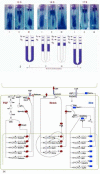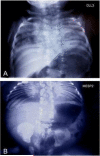Vertebrate segmentation: from cyclic gene networks to scoliosis
- PMID: 21620133
- PMCID: PMC3164975
- DOI: 10.1016/j.cell.2011.05.011
Vertebrate segmentation: from cyclic gene networks to scoliosis
Abstract
One of the most striking features of the human vertebral column is its periodic organization along the anterior-posterior axis. This pattern is established when segments of vertebrates, called somites, bud off at a defined pace from the anterior tip of the embryo's presomitic mesoderm (PSM). To trigger this rhythmic production of somites, three major signaling pathways--Notch, Wnt/β-catenin, and fibroblast growth factor (FGF)--integrate into a molecular network that generates a traveling wave of gene expression along the embryonic axis, called the "segmentation clock." Recent systems approaches have begun identifying specific signaling circuits within the network that set the pace of the oscillations, synchronize gene expression cycles in neighboring cells, and contribute to the robustness and bilateral symmetry of somite formation. These findings establish a new model for vertebrate segmentation and provide a conceptual framework to explain human diseases of the spine, such as congenital scoliosis.
Copyright © 2011 Elsevier Inc. All rights reserved.
Figures





References
-
- Ahn UM, Ahn NU, Nallamshetty L, Buchowski JM, Rose PS, Miller NH, Kostuik JP, Sponseller PD. The etiology of adolescent idiopathic scoliosis. American journal of orthopedics (Belle Mead, NJ. 2002;31:387–395. - PubMed
-
- Aulehla A, Johnson RL. Dynamic expression of lunatic fringe suggests a link between notch signaling and an autonomous cellular oscillator driving somite segmentation. Dev Biol. 1999;207:49–61. - PubMed
-
- Aulehla A, Wehrle C, Brand-Saberi B, Kemler R, Gossler A, Kanzler B, Herrmann BG. Wnt3a plays a major role in the segmentation clock controlling somitogenesis. Dev Cell. 2003;4:395–406. - PubMed
Publication types
MeSH terms
Grants and funding
LinkOut - more resources
Full Text Sources
Medical
Miscellaneous

